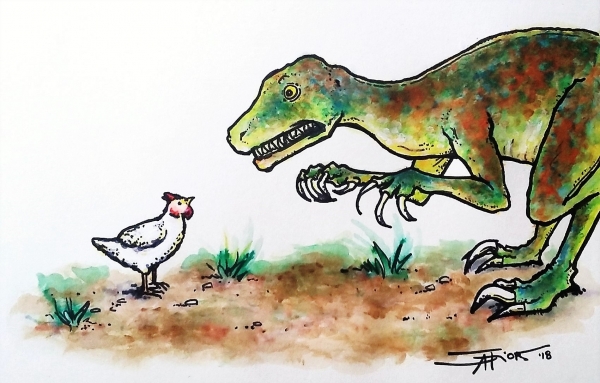At first glance, a chicken and a dinosaur may seem as distantly related as any two species could be. For Hans Larsson, McGill associate professor of paleontology and biology and director of the Redpath Museum, the correlation between the two could not be clearer.
In his presentation on Sept. 14, “Freaky Friday: Weird things I know about dinosaurs and chickens,” Larsson unveiled new findings in vertebrate anatomy enabling him to extrapolate knowledge about extinct species by studying living ones. The developments were first observed in a lesser-known genus of fish, the polypterus, which has the ability to spend long durations of time outside the water.
“We went back and looked at the fossil record from 400 million years ago as fish transitioned to land,” Larsson said. “We isolated many hotspots for change from the skeletal plasticity.”
Among their findings was a notable thinning of the pectoral girdle, the skeletal framework where the forelimbs are attached to the shoulders. What is astonishing is not the changes themselves, but the short timespan in which the polypterus’ morphology evolved.
Darwin’s theory of evolution states that random mutations cause observable, or ‘phenotypic,’ changes which are passed down to individuals when they become selectively advantageous. Larsson’s model challenges the most basic tenets of this theory by arguing that environmental factors, not just genetic variability, are the cause of physical changes.
If an organism’s phenotype is malleable over the course of it’s lifetime, anatomical variations could theoretically become ‘fixed’ on the genetic level.
“We are not looking at evolution here, we’re seeing phenotypic plasticity,” Larsson said. “The fact that the body can respond [to the environment] could be a major source of variation for evolutionary changes.”
Under this precedent, Larsson and his team turned their attention from fish to investigations on chickens.
“In birds, [morphology changes are] distributed in three hotspots,” Larsson said. “One is on the beak, one is where the jaw attaches to the palette, and one is at the very back of the skull.”
Much like the polypterus making its way onto land, birds may have been using muscle action to develop their skeletal features for flight, inducing modifications as a response to changing environmental, rather than genetic, factors. Using this as a model, Larsson suggests that the egg, like the womb, can act as an environmental catalyst for developmental changes.
In their research, the Larsson lab has been paralyzing chicken embryos at various stages and recording how each evolved specimen’s skeleton changes over its incubation period. Features such as the shape of the backbone, length of the beak, and jaw articulation were all affected in embryos that had been paralyzed. The wings, too, were affected. The lengths of bones and cartilage structure varied among specimens that had varying degrees of movement within the egg.
“All of this surrounds the larger topic of how we think about birds today, dinosaurs, and embryos in terms of environmental biology,” Larsson said. “Our solution was ‘chickenosaurous’”.
Their idea is not novel but involves the reverse engineering of chicken embryos to resemble structural features of dinosaurs. In doing so, researchers gain an evolutionary snapshot of dinosaur development, the first step in the process of uncovering how ancient organisms made the leap from sea to land and, finally, into air.
The ‘Freaky Friday’ series continues at the Redpath Museum on October 12, from 12p.m. to 1p.m.. Admission to lectures is free.









